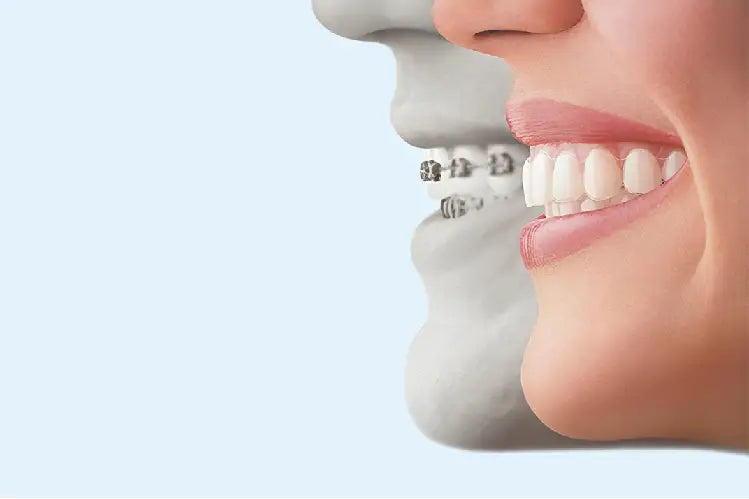
A perfect smile is more than just a cosmetic luxury, it's your best accessory to boost confidence, which will lead to more opportunities. Most importantly, it improves your oral health and overall functionality of your teeth. If you are thinking of getting an orthodontic treatment, you may already have faced the ongoing debate on Aligners vs. Braces.
Making a decision can feel overwhelming with all of the options available today. This comprehensive guide will walk you through everything you need to know and compare clear aligners to traditional orthodontic treatment. We will discuss appearance and comfort, effectiveness, maintenance, restrictions, length of treatment, and cost, so you can make an informed decision.
What Are Clear Aligners?

Clear aligners are a revolutionary innovation in the field of orthodontics. Before they appeared, options for teeth straightening were limited, mostly to visible, metallic methods.
The first major step came in 1997 when two Stanford students introduced an orthodontic system using a series of transparent plastic trays that progressively adjusted the teeth. The concept was simple yet powerful: to offer a nearly invisible, removable alternative to metal braces.
Since then, clear aligners have transformed the dental industry. Today, aligners are crafted using advanced 3D imaging, precise modeling, and biocompatible plastics that gently move teeth without the discomfort or aesthetic issues often associated with metal braces.
More recently, companies like ALIGNERCO have made clear aligners even more accessible by offering high-quality, affordable, at-home treatments, a game-changer for many busy adults and teens.
What Are Traditional Metal Braces?

Traditional orthodontic treatment with metal braces has been around in some form for centuries. Archaeologists have found evidence of early dental devices in ancient Egyptian tombs, hinting that people have long desired straight teeth. However, modern metal braces as we know them emerged in the early 20th century, when dentists began using stainless steel brackets and wires to correct dental misalignments reliably.
Traditional metal braces consist of metal brackets and wires that are bonded to each tooth. These wires and brackets exert a gradual pressure on misaligned teeth, moving them to their ideal positions over time.
With the advancement in technology, the braces have also evolved.
- They’ve got smaller and more comfortable brackets now.
- More forms of braces have been introduced, like tooth colored ceramic braces, or lingual braces that are placed on the back of your teeth.
- Improved materials are being used for faster results and better aesthetics.
Even today, many people choose metal braces as their solution for complex orthodontic issues that clear aligners might struggle to fix.
Aligners vs. Braces: What’s the Difference?
Now let's dig into a side-by-side clear aligners comparison with traditional orthodontic treatment, breaking down all the major factors you should consider.
Appearance
-
Clear Aligners:
Aligners are virtually invisible. No one will notice you are wearing anything on your teeth until you tell them. This makes aligners an especially appealing choice for adults and professionals who are conscious of their appearance. -
Braces:
Metal braces are highly visible, although customization options like various braces colors are available to allow a personalized look. Opt for a stylish monochrome look with black braces for a modern vibe, or go all punk with neon shades. You’re only limited by your reservations.
Comfort Level
-
Clear Aligners:
Made from smooth plastic, clear aligners are gentle on the mouth’s soft tissues. You may feel pressure when switching to a new set, but you won’t deal with poking wires or sharp brackets. -
Braces:
The wires and brackets used in traditional braces can irritate your lips and cheeks. Orthodontic wax helps, but adjustments (tightening wires) can cause recurring discomfort.
Effectiveness
-
Clear Aligners:
Best suited for mild to moderate issues like minor crowding, spacing, or slightly misaligned bites. Aligners like those from ALIGNERCO can produce stunning results for patients who consistently wear them for the recommended 20–22 hours a day. -
Braces:
Traditional braces are capable of treating complex and severe orthodontic problems, like severe overcrowding, significant bite issues (overbite, underbite, crossbite), and large tooth gaps. Braces offer fine-tuned control over individual tooth movements that aligners sometimes can't replicate.
Maintenance and Convenience
-
Clear Aligners:
Very easy to maintain. Simply remove them to eat, brush, and floss. Cleaning involves gently brushing the aligners and soaking them in special solutions or clear water. -
Braces:
Maintaining oral hygiene with braces can be tricky. Food often gets stuck between wires and brackets, requiring special floss threaders, interdental brushes, and a lot more patience.
Dietary Restrictions
-
Clear Aligners:
Eat whatever you want! As clear aligners can be removed when eating, they come with absolutely no food restrictions. -
Braces:
Hard, sticky, and crunchy foods are off-limits to prevent damaging wires or brackets. You’ll need to avoid things like popcorn, nuts, caramel, hard candies, etc.
Treatment Duration
-
Clear Aligners:
Clear aligners’ treatment duration typically ranges between 4 to 6 months, depending on the severity of the case and patient compliance. At-home providers like ALIGNERCO streamline the process further with custom plans. -
Braces:
Average treatment spans 12 to 24 months. Severe cases may take longer, especially when significant jaw correction is needed.
Costs
-
Clear Aligner:
Thanks to companies like ALIGNERCO, clear aligners are more affordable than ever. When you evaluate the cost difference between aligners and braces, aligners often come out as the more budget-friendly option, starting from as low as , especially considering the convenience of at-home impressions and no office visits. -
Braces:
Traditional braces can be pricier, starting from approximately $3,000 and going up to $10,000. The prices can vary, especially because of frequent orthodontist visits and emergency repairs.
Pros and Cons of Clear Aligners and Traditional Braces
Here’s a simple but thorough table outlining the pros and cons of clear aligners and traditional braces:
Traditional Braces Pros
- Effective for a wide range of complex orthodontic problems, including severe bite issues and significant overcrowding.
- Provides fine-tuned control over individual tooth movements.
- No need for the user to remember to wear them, as they are permanently attached.
Traditional Braces Cons
- Nearly invisible, providing a discreet treatment option.
- Smooth edges for minimal irritation.
- Best suited for mild to moderate orthodontic issues.
- Easy to clean and maintain.
- No dietary restrictions, as aligners are removable.
- Shorter treatment duration, typically 4-6 months.
- More affordable compared to traditional braces (especially with companies like ALIGNERCO).
Clear Aligners Pros
- They’re highly visible.
- Can irritate the gums and inside of the mouth due to brackets and wires.
- Maintenance is time-consuming.
- Dietary restrictions.
- Longer treatment duration, typically ranging from 18–36 months.
- Higher cost due to frequent orthodontist visits and potential need for repairs.
Clear Aligners Cons
- Not as effective for complex orthodontic issues.
- Requires consistency.
- Might not work well for children or younger teens with growing mouths.
ALIGNERCO: Your Perfect Smile Partner
When it comes to balancing effectiveness, affordability, and convenience, ALIGNERCO stands out. Here's why so many people are choosing them for their invisible aligners treatment:
Ease and Comfort
ALIGNERCO clear aligners are made from BPA-free , medical-grade plastic designed for a snug yet comfortable fit. Most users adapt within the first week, making the transition smoother than with traditional metal braces.
At-Home Treatment
ALIGNERCO eliminates the need for constant dental visits. Here's how it works:
- Order your impression kit online.
- Take easy impressions at home.
- Send them back to ALIGNERCO’s experts.
- Receive a custom treatment plan and aligners delivered straight to your door!
Affordability
One of ALIGNERCO’s biggest advantages is its cost structure. Compared to traditional braces (which can cost $3,000 or more), ALIGNERCO’s plans start at a fraction of the price. Plus, they offer financing options for added flexibility, making it easier than ever to invest in your smile.
Guarantee and Support
ALIGNERCO also offers refinements (additional aligners) if your teeth need extra adjustments, ensuring that you get the results you expect.
Aligners vs. Braces: The Choice Is Yours
When choosing between braces vs. aligners for adults, you should think through your dental needs, personal preferences, lifestyle, and budget. As this clear aligners comparison indicates, aligners like ALIGNERCO provide incredible convenience, discretion, and savings for most adults and teens. But if you have a more complex orthodontic case, traditional orthodontic treatment with braces may be the best choice.
Ultimately, whether you choose braces or clear aligners, your goal is the same, which is a healthier, beautiful smile. Smile big, smile bright, and make your choice!
FAQs
1. Which one is better, braces or aligners?
Braces are more effective for severe dental issues, whereas clear aligners are great for mild to moderate malocclusions.
2. What are the disadvantages of aligners?
Aligners can be less effective for severe dental issues, require strict adherence to wearing them, and may not be suitable for younger children.
3. Which is better, ceramic braces or aligners?
Ceramic braces offer a more discreet option compared to traditional metal braces, but are still visible. Aligners are the most discreet but may not work for complex cases.
4. How do I know if I need braces or aligners?
Consult an orthodontist to assess your dental needs. If you have mild to moderate misalignment, aligners may be sufficient. For more complex issues, braces might be necessary.
Citations:
Clear aligners or metal braces? Here’s how to choose. (n.d.). Colgate. https://www.colgate.com/en-us/oral-health/adult-orthodontics/clear-aligners-or-metal-braces-heres-how-to-choose
CentralCoastOrthodontics. (2022b, December 28). Braces vs Aligners – Which Will Suit You Better? Orthodontics Articles. Central Coast Orthodontics. https://centralcoastorthodontics.com.au/braces-vs-aligners-which-will-suit-you-better/






